EF9. How Does Energy Flow in Living Systems?
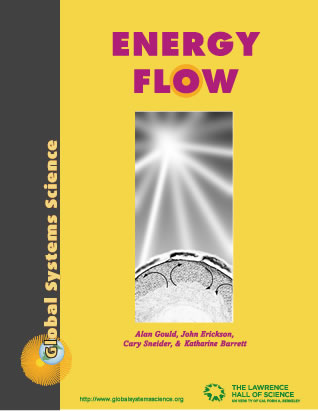
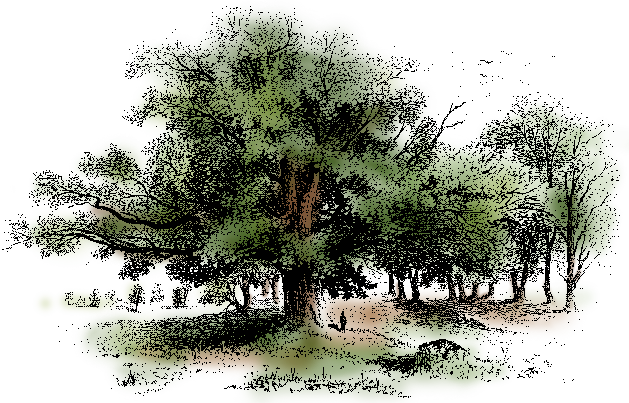
Lush green grass from winter rainstorms carpets the hillside, punctuated here and there with ancient oak trees. Zooming in on one of the trees we see that it’s alive with hundreds of oak caterpillars, munching holes in the leaves. It’s a feast day for squirrels and blue jays, flitting among the branches collecting acorns, and occasionally stopping to gobble a tasty caterpillar. The squirrel stops to scratch a flea. A pair of chickadees hop through the branches collecting caterpillars for their chicks that are waiting eagerly in their hole nest in the trunk. Animal droppings, egg shells, leaves and dead insects fall to the ground beneath the tree. Soil organisms such as earthworms, mushrooms and bacteria consume this organic matter, breaking it down into nutrients that can be taken up by the tree roots.
Ecologists use the term food web to describe the system of relationships that allows energy to flow from one organism to another. Food webs are seldom simple. If we diagram an example like the oak tree, with arrows pointing to the consumers of energy, we end up with quite a complex picture.
I. Energy Transfer Through Food Webs
The ultimate source of energy is the Sun. In an ecosystem, it is only the green plants that are able to trap the Sun’s energy to produce food. Even animals that just eat other animals must include in their diet animals that have eaten plants, or that eat other animals that eat plants. Plants have the capability of transforming the radiant energy of sunlight into the chemical energy stored in food. Ecologists are scientists who study the relationships among living organisms and how they interact with their environment. They call plants producers because they are the only organisms that can produce food from sunlight. Without the producers, animals (including humans) could not survive.
Non-producer plants and animals have evolved strategies to get stored chemical energy—food—from green plants. The chart on the next page summarizes the categories that describe the different ways that plants and animals get food to survive.
II. Components of Food Webs
A Food Web
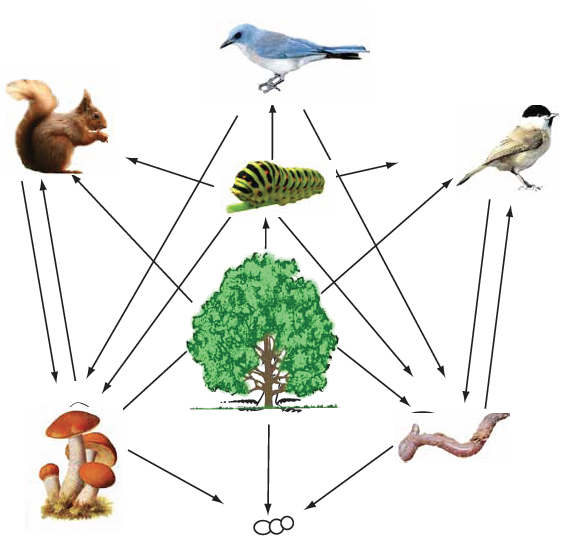
Producers: Organisms that add energy to an ecosystem. These organisms are green plants that trap light energy to make sugars through photosynthesis.
Herbivores: Animals that eat living plants.
Carnivores: Animals that eat other live animals.
Omnivores: Animals that eat both plants and animals.
Scavengers: Animals that eat dead and decaying organisms.
Parasites: Organisms that take nutrients directly from other living plants or animals.
Decomposers: Organisms such as fungi and bacteria that break down dead organisms into nutrients for plants.
Question 9.1
Study the Oak Food Web diagram on the previous page. What plant is the producer? What animals would you classify as omnivores? What animal is a scavenger? Can you find an example of each energy-getting strategy in this simplified version of an oak food web?
Question 9.2
What are some other organisms that could be part of this oak food web?
Question 9.3
Make a diagram of a food web that includes you. Identify the producers, herbivores, carnivores, omnivores, scavengers, parasites, and decomposers for your food web.III. How Do Plants Produce Food?
Plants use solar energy to power chemical reactions inside their cells. These reactions transform simple carbon dioxide and water molecules into a more complex chemical called a sugar. Sugars molecules contain carbon (C), hydrogen (H), and oxygen (O) atoms. It takes energy to build sugar molecules; and when they are broken down they release that energy.
The chemical reaction in which plants build sugar molecules is called photosynthesis. It is actually a multi-step reaction that is only partly understood by biochemists. (If the reaction were completely understood, perhaps we could create food in the laboratory without green plants.) Below is a simplified equation which shows the starting and ending points of photosynthesis in green plants.
As the leaves of a plant produce sugar molecules, other areas of the plant use the sugar for various life functions. For example, oak trees need to produce new tissues to replace the leaves eaten by the caterpillars, and new acorns to replace those devoured by the squirrels and blue jays. So, the sugars produced by the plant flow through veins in the leaves and branches to where they are needed. There the energy is released in a process known as respiration. The great majority of living organisms, including plants, animals (and people), as well as many bacteria, use the process of respiration to get the energy out of sugars to run our life processes, whether it be growing new tissue, making our muscles move, warming our bodies, or electrical activity in our brains that we call “thinking.”
When you light a candle, you are starting a chemical reaction in which oxygen combines with molecules in the candle wax to release heat and light energy. We call it “burning.” Respiration is a similar process, in that oxygen is combined with sugar molecules, releasing energy. The process is shown below.
IV. Energy Loss in the Food Web
The matter which makes up the bodies of plants and animals, both living and dead, is called biomass. This biomass includes the chemical energy stored in the tissues of the organism. As plants are eaten by herbivores, and herbivores are eaten by carnivores or scavengers, matter with stored chemical energy is transferred from one organism to the next.
When one organism is eaten by another, much of the original biomass, along with its stored energy, is lost to the food web. In the case of plants for example, the roots, dead leaves, and stems of the plant may be left behind.

Some of the biomass of an animal that is eaten by a scavenger may be left unused as bones or feathers. Furthermore, not all of the energy in biomass that is consumed is used, since no machine—mechanical or living—is 100% efficient. Some of the biomass is not digested and is eliminated. Some is lost in the form of heat.
This transfer and loss of energy and biomass can be illustrated with a pyramid. The drawings on this page show the consumption of energy and biomass that might occur each time one kind of organism is eaten by another. An ecosystem usually needs many more producers to support fewer herbivores, and many herbivores to support fewer carnivores.
Humans are omnivores. We can eat plants or animals. In the United States people eat much more meat than in other countries. This means that we make very inefficient use of biomass. For example, it is estimated that it takes 1,000 calories of sunlight to produce just one tenth of a calorie of energy from beef. The world’s resources would go much further if people obtained more of the nutrients that they needed from plants than from animals. This is also in accord with recommendations of many nutritionists—that people should eat a lot more grains, vegetables and legumes than meat to achieve a healthy diet.V. Energy Stored in the Ground
On the forest floor, leaves, pine needles, fruits, cones, and other debris that has fallen from the canopy builds up, forming a rich layer of organic material. This deposit of carbon-rich plant material is home to a myriad of small invertebrates, fungi and microorganisms that feed on the cellulose and animal matter, thereby returning many of the nutrients to the soil, where they are absorbed by new plants and eaten by other animals.
Decomposition and decay are processes that most of us try to avoid! Dead things smell when they break down and look really weird. But for all its unpleasant aspects, organic decomposition is essential to the well-being of life on Earth. The nutrients and energy within living things get passed on to future generations of organisms via the hidden world of scavengers and decomposers. In your lifetime, you will eat about 45,000 kg (50 tons) of “second hand” food made up of recycled nutrients! The unappreciated “realm of the rotten” helps us stay alive.
Not all plant and animal debris is immediately recycled. In cold polar regions and at high mountain elevations large deposits of organic matter have formed. When plants growing in these frozen environments die, they accumulate layer after layer, eventually forming a substance called peat. Peat also forms in bogs, where the amount of free oxygen is limited, slowing the process of decay. People in the British Isles, Northern Europe and the Arctic have a long history of mining and burning peat as fuel.
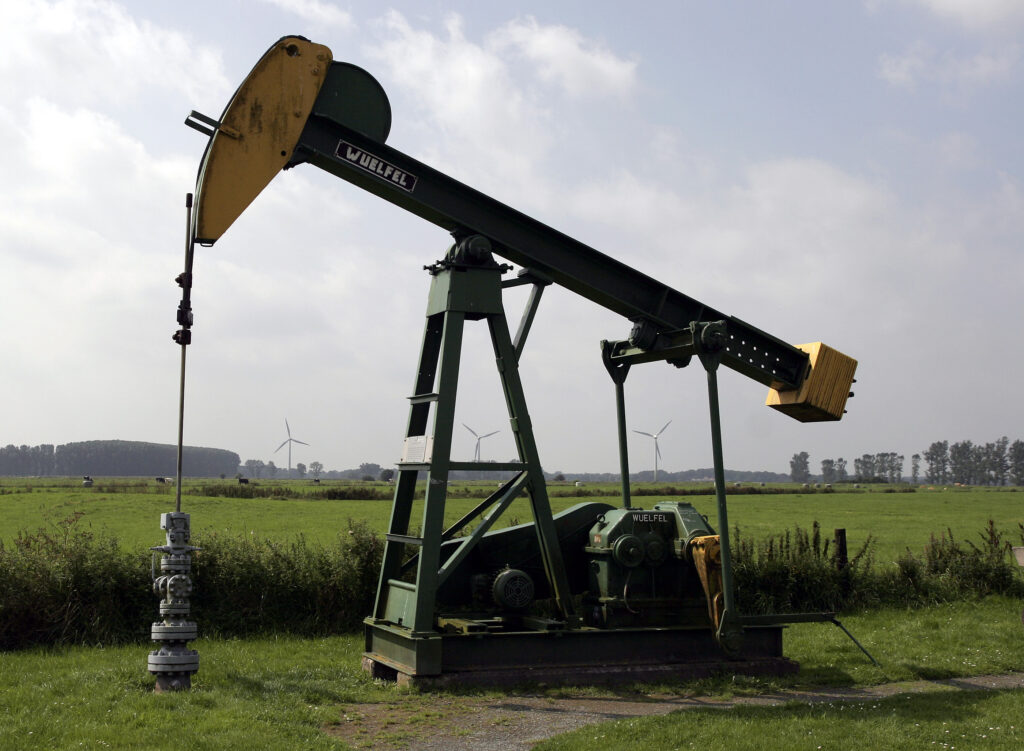
During the carboniferous period, 400 million years ago, large stands of ancient forests grew and died in swampland, adding layer upon layer of peat. This peat was buried by other sediments. After millions of years, the compressed sediments formed black and brown rocks that we call coal. Coal burns because it contains the partially decayed remains of plants and animals. Remains of marine plants and animals deposited on the ocean floor that are buried under layers of sediment eventually turned to oil and natural gas. Coal, oil, and natural gas are called fossil fuels.
When our use of fossil fuels was limited, there were no serious problems. But as our population has grown, and the level of industrialization has increased in the world, certain problems have become apparent:
- Fossil fuels pollute the environment where they are burned, causing dangers to people and other living things.
- The burning of fossil fuels releases carbon dioxide gas. The concentration of carbon dioxide in the atmosphere has increased substantially since the beginning of the industrial revolution, and the rate of increase is growing. This change in our atmosphere can lead to global warming.
- Since fossil fuels are limited in quantity, their cost will increase as the most easily extracted fuel deposits are exhausted. When fuel costs increase, so will the costs of everything that requires fuel for production or transportation—including food, clothing, and housing.
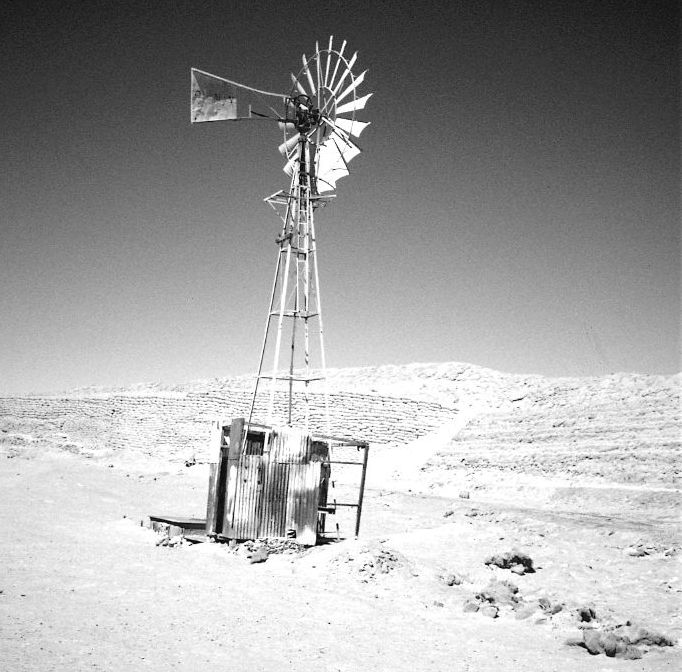
If we use the energy in sunlight directly, or harness wind energy which derives from sunlight, rather than fossil fuels, perhaps we can avoid some of these problems.
VI. Conclusion

When we enjoy the beauty of a tree we probably aren’t thinking of this marvelous structure as a carbon-based system that transforms sunlight and gases into food. A single cell in a tree leaf is a tiny chemical factory that uses light energy from the Sun plus water and carbon dioxide from the air to produce sugar. All life on the planet depends on this very commonplace but remarkable process.
While a leaf on a single oak tree may not seem terribly important at first glance, it takes on greater importance when we realize that energy cannot enter living systems without it. If we want to maintain a livable habitat on Earth, we need to learn as much as possible about how energy flows through living systems—from the level of a single cell to the level of the entire planet.
Life is fragile, yet has persevered on our planet for billions of years. We have energy flowing within us and all around us, from the minuscule energy flows in our nerve cells to the most powerful blasts of energy in volcanoes, earthquakes, tornadoes, hurricanes, and supernova explosions. While in our day to day experience we are mostly conscious of the moderate flows of energy around us (movement of cars and trucks, people walking and talking, waves on a beach, streams flowing), most of these modest energy flows stem from the inconceivably intense energy source in the core of the Sun.
Recognizing the different forms of energy and how they flow through Earth systems is very important if we are to understand the natural processes on which our lives depend. Earthquakes and volcanoes depend on the way energy is released by radioactive materials deep inside the planet. Our climate and weather depend on the way solar energy heats the atmosphere, surface, and oceans. Life itself depends on the ability of green plants to combine water and carbon dioxide in the presence of sunlight to produce food. The rare impact of a large comet, or a nearby supernova are other sources of energy that may someday have a profound effect on life as we know it.
While understanding the flow of energy is important from a scientific point of view, it can also enrich the way you perceive the world around you. We encourage you to appreciate the myriad varieties of energy flow surrounding you, much as you would appreciate works of art and music, which are themselves no more—and no less—than flows of energy.

EF9.1. Investigation:
How Does the Flow of Energy Affect You?
This book has touched on a variety of ways that energy flows through the Earth system, making things happen. While we have focused on spectacular displays of energy from Mount St. Helens to a tornado, we have also discussed the way we experience energy everyday—in the form of wind, rain, warmth, light and sound, food, and the use of fossil fuels.
1. Select one aspect of energy that is most relevant to your life or that you find most interesting. Write an outline for an essay about it that reveals:
- The source or sources of energy involved.
- How the energy is transformed from one form to another.
- How the energy flows through the Earth system.
- •How you experience the energy and why it is important to you.
- What happens to the energy after you experience it, keeping in mind the Law of Conservation of Energy.
2. Discuss your outline with a classmate. Ask questions to help you improve the essay, such as:
- Did I define the aspect of energy that I want to write about clearly?
- Did I show how the flow of energy is important to me?
- What have I forgotten to take into account?
- What could I do to help a reader who has not read Energy Flow to get interested in my essay, and understand my point of view?
3. Write a draft of the essay. Exchange essays with your friend. Give each other comments and suggestions, and write a final draft.

